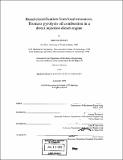Rural electrification from local resources : biomass pyrolysis oil combustion in a direct injection diesel engine
Author(s)
Shihadeh, Alan Louis, 1967-
DownloadFull printable version (10.18Mb)
Advisor
Simone Hochgreb and John B. Heywood.
Terms of use
Metadata
Show full item recordAbstract
As the production process continues to be refined, biomass pyrolysis oils are increasingly being considered as potentially feasible renewable fuels. Combustion of pyrolysis oils in diesel engines has been scarcely studied, and the few studies which have been performed indicate that these fuels exhibit excessively long ignition delay, rendering them dependant on auxiliary ignition sources for diesel engine operation. This work focuses on examining what physical and chemical processes may explain poor pyrolysis oil ignition quality, and what can be done to improve it. In addition, biomass oil combustion is characterized in relation to No. 2 diesel fuel combustion. To investigate linkages between biomass pyrolysis production techniques and the combustion characteristics of the resulting liquids, combustion experiments with pyrolysis oils produced through two differing processes-ENSYN Rapid Thermal Process, and NREL Ablative Vortex Pyrolysis-were examined, with particular attention to the effects of the severity of thermal cracking, volatiles collection and preservation, and extent of feedstock drying. Each of these process parameters was in turn mapped to particular fuel properties, including average molecular weight, volatile species content, water concentration, and physical properties and quantified using various chemico-physical analytic methods. It was found that the NREL oil had considerably lower water content (16.9 versus 26.3 wt %) and average molecular weight (370 versus 550 g/mol) in comparison to the ENSYN oil; little difference in the atomization characteristics and volatile species profile were found. Using a single cylinder, naturally aspirated direct injection diesel engine, it was found that the NREL pyrolysis oil ignited more readily than the ENSYN oil, though both oils exhibited excessive ignition delay and could not ignite without assistance from combustion air pre-heating. Investigation with a hydrated NREL oil whose water content equaled that of the ENSYN oil revealed that the lower water content only partially accounted for the better ignition quality of the NREL oil, and that the increased thermal cracking severity of the NREL oil accounted for the remainder. Experimental ignition delay and heat release data were interpreted using a phenomenological spray combustion model. The results showed that the long ignition delay of the pyrolysis oils results from slow chemistry, not slow vaporization, and that pyrolysis oil combustion is predominantly kinetically-controlled, in contrast to the predominantly mixing-controlled diesel combustion. Water was found to account for 15% and 20% of the ignition delay time for the NREL and ENSYN oils, respectively. While the role of water was significant, longer ignition delay and slower combustion rates were found to be inherent to fuel chemical structure, which in turn appears to be upgraded with additional thermal cracking.
Description
Thesis (Sc.D.)--Massachusetts Institute of Technology, Dept. of Mechanical Engineering, 1998. Includes bibliographical references.
Date issued
1998Department
Massachusetts Institute of Technology. Department of Mechanical EngineeringPublisher
Massachusetts Institute of Technology
Keywords
Mechanical Engineering